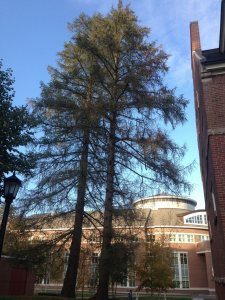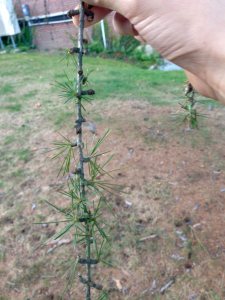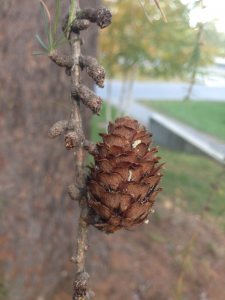European Larch
Larix decidua | Family: Pinaceae
Submission: Paige Guevarra ‘18
Identification:
Needles – yellowish-green
Cones – roughly 1-1¼” long, ovoid, and hairy with non-reflexed scales
Twigs – young twigs are straw-colored and glabrous; pendant
Natural History:
The native range of European larch (Larix decidua) is in the European Alps from Switzerland to Italy. European larch can grow to be anywhere from 30 to 130 feet tall in North America, but has been found naturally to grow up to 177 feet in the Alps. Most individuals live for 100-150 years, but in the Alps, some individuals have been found to live for over 600 years. Since its introduction to North America, European larch has become successful in growing and reproducing in its non-native region, meaning that it has become naturalized, particularly in New England. The natural ecological conditions for growth are subalpine on granitic rock from elevations of 4500 to 6500 feet. Optimal elevation for growth and development occurs roughly at 5000 feet, however at these elevations there is competition with other trees such as Norway spruce (Picea abies) or Silver fir (Abies alba). Since its expansion beyond the Alps, European larch has grown in temperate regions with moist, neutral to acidic soil on well-drained sites, and in most places in North America is planted as an ornamental tree.
 The uses of European larch are widely due to its strength and durability, moderate to high density, stiffness, and fast growth rate. European larch is a pioneer species that is intolerant to shade, meaning that when the species has ample sun and nutrients, it tends to grow very quickly, even on disturbed soils. For this reason, European larch has been used to rehabilitate sites that have experienced extensive disturbance and to convert otherwise useless land into a forest. It is also used as a starter species in order to prepare a section of land for the growth of hardier species with greater demands. European larch is often grown solely for the commercial use of its wood, especially as timber for building frames, log houses, flooring strips, roof tiles, and as pulp to make paper. Because European larch wood is fairly rot resistant, it has been used for poles, posts, railroad ties, props in mines, and supportive pilings for buildings. The wood itself is aesthetically pleasing, and has been used as veneer and other decorative purposes.
The uses of European larch are widely due to its strength and durability, moderate to high density, stiffness, and fast growth rate. European larch is a pioneer species that is intolerant to shade, meaning that when the species has ample sun and nutrients, it tends to grow very quickly, even on disturbed soils. For this reason, European larch has been used to rehabilitate sites that have experienced extensive disturbance and to convert otherwise useless land into a forest. It is also used as a starter species in order to prepare a section of land for the growth of hardier species with greater demands. European larch is often grown solely for the commercial use of its wood, especially as timber for building frames, log houses, flooring strips, roof tiles, and as pulp to make paper. Because European larch wood is fairly rot resistant, it has been used for poles, posts, railroad ties, props in mines, and supportive pilings for buildings. The wood itself is aesthetically pleasing, and has been used as veneer and other decorative purposes.
References:
Brockman, C.F. Trees of North America: A Guide to Field Identification. Revised Edition. Western Pub. Co., Inc. 280pp.
Christman, Steve. “Larix Decidua Plant Profile.” Floridata Plant Encyclopedia. Floridata, 3 Jan. 2001. Web. 01 Nov. 2015. <http://www.floridata.com/Plants/Pinaceae/Larix%20decidua/195>.
Elias, T.S. 1980. The Complete Trees of North America Field Guide and Natural History. Van Nostrand Reinhold Co., N.Y. 948pp.
Harlow, W.M., Harrar, E.S., Hardin, J.W. and White, F.M. 1991. Textbook of Dendrology. McGraw-Hill Inc., N.Y. 501pp.
Matras J. and Pâques L. 2008. EUFORGEN Technical Guidelines for genetic conservation and use for European Larch (Larix decidua). Bioversity International, Rome, Italy. 6 pages.
Petrides, G.A. 1972, A Field Guide to Trees and Shrubs. 2nd edition. Houghton Mifflin Co., Boston. 428pp.
Preston, R.J., Jr. 1989. North American Trees. 4th edition. Iowa State Univ. Press. Ames. 407pp.
Shane, J. 2004. Dendrology Handbook, University of Vermont, Unpublished.
Sullivan, Janet. 1994. Larix decidua. In: Fire Effects Information System, [Online]. U.S. Department of Agriculture, Forest Service, Rocky Mountain Research Station, Fire Sciences Laboratory (Producer). Available: http://www.fs.fed.us/database/feis/ [2015, November 1].
